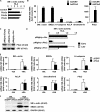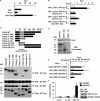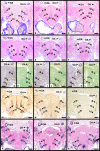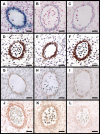Pitx2 is functionally important in the early stages of vascular smooth muscle cell differentiation
- PMID: 18458156
- PMCID: PMC2364692
- DOI: 10.1083/jcb.200711145
Pitx2 is functionally important in the early stages of vascular smooth muscle cell differentiation
Abstract
Mechanisms that control vascular smooth muscle cell (SMC) differentiation are poorly understood. We identify Pitx2 as a previously unknown homeodomain transcription factor that is rapidly induced in an in vitro model of SMC differentiation from multipotent stem cells. Pitx2 induces expression of multiple SMC differentiation marker genes by binding to a TAATC(C/T) cis-element, by interacting with serum response factor, and by increasing histone acetylation levels within the promoters of SMC differentiation marker genes. Suppression of Pitx2 reduces expression of SMC differentiation marker genes in the early stages of SMC differentiation in vitro, whereas Prx1, another homeodomain protein, regulates SMC differentiation marker genes in fully differentiated SMCs. Pitx2, but not Prx1, knockout mouse embryos exhibit impaired induction of SMC differentiation markers in the dorsal aorta and branchial arch arteries. Our results demonstrate that Pitx2 functions to regulate the early stages of SMC differentiation.
Figures








Similar articles
-
Kruppel-like factor 4, Elk-1, and histone deacetylases cooperatively suppress smooth muscle cell differentiation markers in response to oxidized phospholipids.Am J Physiol Cell Physiol. 2008 Nov;295(5):C1175-82. doi: 10.1152/ajpcell.00288.2008. Epub 2008 Sep 3. Am J Physiol Cell Physiol. 2008. PMID: 18768922 Free PMC article.
-
PIAS1 activates the expression of smooth muscle cell differentiation marker genes by interacting with serum response factor and class I basic helix-loop-helix proteins.Mol Cell Biol. 2005 Sep;25(18):8009-23. doi: 10.1128/MCB.25.18.8009-8023.2005. Mol Cell Biol. 2005. PMID: 16135793 Free PMC article.
-
Platelet-derived growth factor-BB represses smooth muscle cell marker genes via changes in binding of MKL factors and histone deacetylases to their promoters.Am J Physiol Cell Physiol. 2007 Feb;292(2):C886-95. doi: 10.1152/ajpcell.00449.2006. Epub 2006 Sep 20. Am J Physiol Cell Physiol. 2007. PMID: 16987998
-
Programming smooth muscle plasticity with chromatin dynamics.Circ Res. 2007 May 25;100(10):1428-41. doi: 10.1161/01.RES.0000266448.30370.a0. Circ Res. 2007. PMID: 17525382 Review.
-
Molecular regulation of vascular smooth muscle cell differentiation in development and disease.Physiol Rev. 2004 Jul;84(3):767-801. doi: 10.1152/physrev.00041.2003. Physiol Rev. 2004. PMID: 15269336 Review.
Cited by
-
Myocardial transcription factors in diastolic dysfunction: clues for model systems and disease.Heart Fail Rev. 2016 Nov;21(6):783-794. doi: 10.1007/s10741-016-9569-0. Heart Fail Rev. 2016. PMID: 27306370 Review.
-
Role played by Prx1-dependent extracellular matrix properties in vascular smooth muscle development in embryonic lungs.Pulm Circ. 2015 Jun;5(2):382-97. doi: 10.1086/681272. Pulm Circ. 2015. PMID: 26064466 Free PMC article.
-
Smooth muscle-selective inhibition of nuclear factor-κB attenuates smooth muscle phenotypic switching and neointima formation following vascular injury.J Am Heart Assoc. 2013 May 23;2(3):e000230. doi: 10.1161/JAHA.113.000230. J Am Heart Assoc. 2013. PMID: 23702880 Free PMC article.
-
Deletion of Krüppel-like factor 4 in endothelial and hematopoietic cells enhances neointimal formation following vascular injury.J Am Heart Assoc. 2014 Jan 27;3(1):e000622. doi: 10.1161/JAHA.113.000622. J Am Heart Assoc. 2014. PMID: 24470523 Free PMC article.
-
WD repeat-containing protein 5, a ubiquitously expressed histone methyltransferase adaptor protein, regulates smooth muscle cell-selective gene activation through interaction with pituitary homeobox 2.J Biol Chem. 2011 Jun 17;286(24):21853-64. doi: 10.1074/jbc.M111.233098. Epub 2011 Apr 28. J Biol Chem. 2011. PMID: 21531708 Free PMC article.
References
-
- Bergwerff, M., A.C. Gittenberger-de Groot, L.J. Wisse, M.C. DeRuiter, A. Wessels, J.F. Martin, E.N. Olson, and M.J. Kern. 2000. Loss of function of the Prx1 and Prx2 homeobox genes alters architecture of the great elastic arteries and ductus arteriosus. Virchows Arch. 436:12–19. - PubMed
-
- Carmeliet, P. 2000. Mechanisms of angiogenesis and arteriogenesis. Nat. Med. 6:389–395. - PubMed
-
- Chen, J., C.M. Kitchen, J.W. Streb, and J.M. Miano. 2002. Myocardin: a component of a molecular switch for smooth muscle differentiation. J. Mol. Cell. Cardiol. 34:1345–1356. - PubMed
-
- Drab, M., H. Haller, R. Bychkov, B. Erdmann, C. Lindschau, H. Haase, I. Morano, F.C. Luft, and A.M. Wobus. 1997. From totipotent embryonic stem cells to spontaneously contracting smooth muscle cells: a retinoic acid and db-cAMP in vitro differentiation model. FASEB J. 11:905–915. - PubMed
Publication types
MeSH terms
Substances
Grants and funding
LinkOut - more resources
Full Text Sources
Molecular Biology Databases
Research Materials

